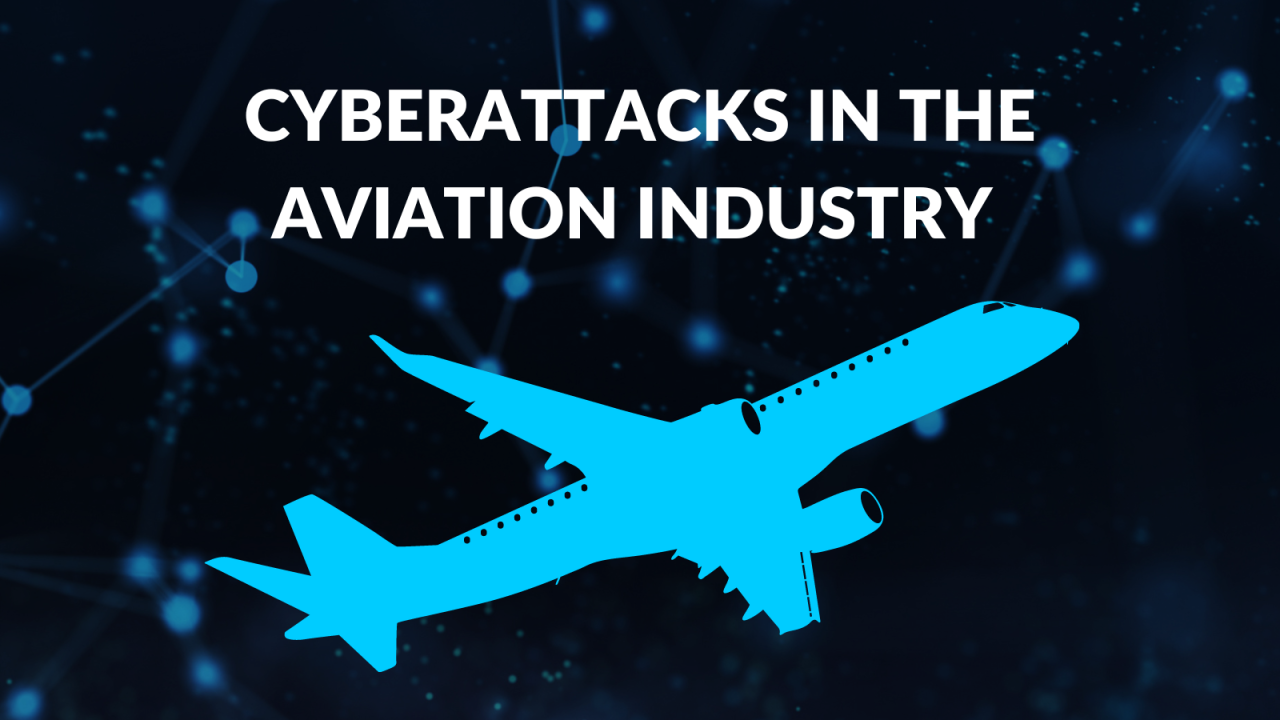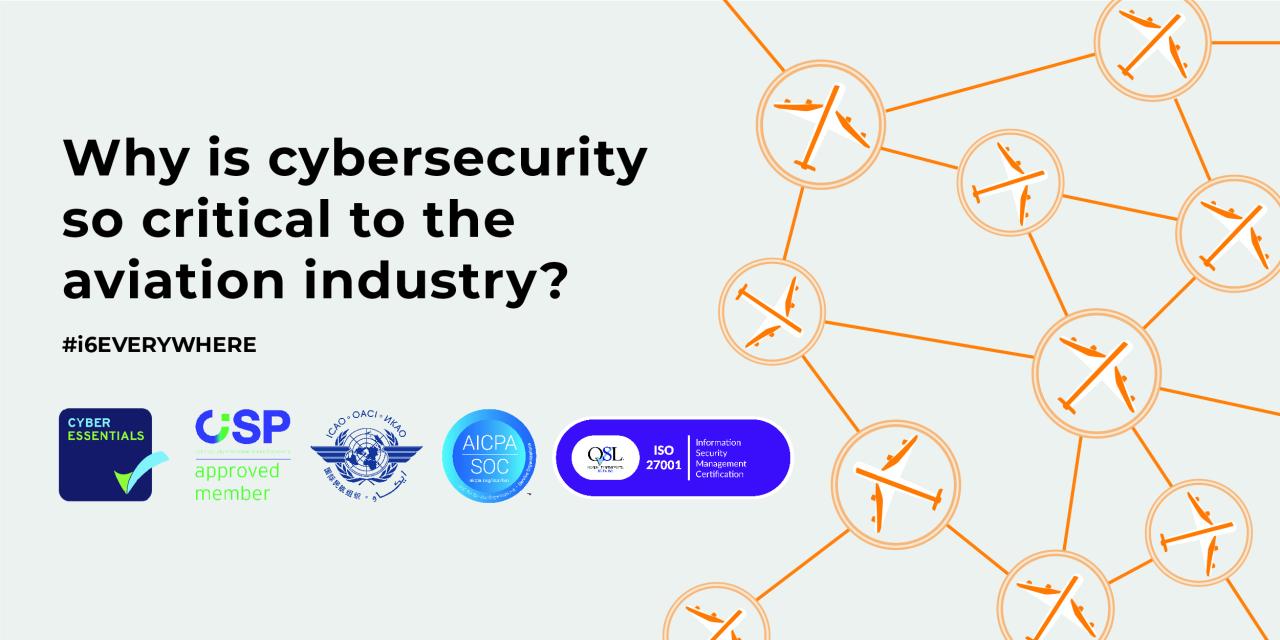
Aviation Industry Extremely Vulnerable to Cyber Threats
Aviation industry is extremely vulnerable to cyber threats – a chilling reality that keeps me up at night. Think about it: our skies, our travel, our interconnected systems are all potential targets for malicious actors. From sophisticated ransomware attacks crippling air traffic control to data breaches exposing millions of passenger records, the potential consequences are staggering. This isn’t just about inconvenience; it’s about safety and national security.
We’re going to delve into the specific vulnerabilities, explore real-world examples, and examine what’s being done (and what needs to be done) to protect the aviation industry from this ever-growing threat.
The interconnected nature of modern aviation—from flight control systems to passenger check-in kiosks—creates a complex web of potential entry points for cyberattacks. A single compromised system can have cascading effects, potentially leading to flight delays, cancellations, and even worse, catastrophic accidents. We’ll explore the different types of attacks, their impact, and the strategies being employed to mitigate these risks.
It’s a fascinating (and slightly terrifying) look into the hidden dangers lurking above us.
The Nature of Cyber Threats in Aviation

The aviation industry, with its complex network of interconnected systems, presents a lucrative and vulnerable target for cyberattacks. The sheer scale and interconnectedness of its infrastructure—from air traffic control systems and flight management systems to passenger check-in kiosks and airline reservation databases—creates a vast attack surface. A successful breach in one area can have cascading effects throughout the entire system, leading to significant disruptions and potential safety hazards.
Understanding the nature of these threats is crucial for mitigating risks and ensuring the continued safety and efficiency of air travel.The interconnected nature of aviation systems means a single point of failure can cause widespread disruption. For instance, a compromised ground handling system could delay numerous flights, while a successful attack on air traffic control could have catastrophic consequences.
This interconnectedness is both a strength and a weakness, offering efficiencies but also creating a larger target for malicious actors. The industry’s reliance on legacy systems alongside newer, more interconnected technologies further complicates the security landscape. Outdated systems often lack the security features of modern software, leaving them susceptible to exploitation.
Types of Cyberattacks Targeting Aviation
Cyberattacks against the aviation industry vary widely in their methods and objectives. Ransomware attacks, designed to encrypt critical data and demand payment for its release, pose a significant threat, potentially grounding flights or disrupting operations for extended periods. Data breaches, which involve the unauthorized access and theft of sensitive passenger information or operational data, can result in financial losses, reputational damage, and legal liabilities.
More serious still are acts of sabotage, where attackers aim to directly compromise the safety and security of aircraft or air traffic management systems. These could range from manipulating flight control systems to causing malfunctions in critical infrastructure.
Examples of Real-World Cyberattacks in Aviation
Several real-world incidents highlight the vulnerability of the aviation industry to cyberattacks. While many incidents remain undisclosed for security reasons, the available information reveals the significant potential impact of these threats.
| Attack Type | Target | Impact | Mitigation Strategy |
|---|---|---|---|
| Ransomware | Airline’s internal network | Disruption of flight operations, delays, financial losses | Robust cybersecurity infrastructure, regular backups, employee training |
| Data Breach | Airline’s passenger reservation system | Exposure of sensitive passenger data, reputational damage, legal penalties | Strong data encryption, multi-factor authentication, regular security audits |
| Phishing | Airport employees | Compromised credentials, potential access to sensitive systems | Security awareness training, multi-factor authentication, strong password policies |
| Denial-of-Service (DoS) | Airport website or check-in systems | Disruption of online services, passenger inconvenience | Redundant systems, distributed denial-of-service mitigation techniques |
Impact on Aircraft Systems
The aviation industry’s increasing reliance on interconnected computer systems makes it incredibly vulnerable to cyberattacks. These attacks don’t just target passenger data; they can directly compromise the systems that control and manage aircraft, leading to potentially catastrophic consequences. The impact extends far beyond simple data breaches, affecting safety, operational efficiency, and passenger confidence.Cyberattacks can severely disrupt various aspects of aircraft operation, from navigation and flight control to in-flight entertainment and communication.
The interconnected nature of these systems means a breach in one area could cascade and compromise others, creating a complex and dangerous situation. The potential for widespread disruption and loss of life highlights the critical need for robust cybersecurity measures within the aviation sector.
Consequences for Aircraft Navigation and Control Systems
Compromised navigation and control systems represent the most serious threat to aviation safety. A successful cyberattack could manipulate flight data, causing the aircraft to deviate from its planned course, potentially leading to mid-air collisions or crashes. Malicious actors could also disable critical systems, resulting in loss of control and a catastrophic outcome. Even subtle manipulations of flight data could lead to significant errors over long distances.
For example, a small, seemingly insignificant alteration to altitude information could accumulate into a major deviation over several hours of flight, creating a dangerous situation for the aircraft and other air traffic.
Risks Associated with Compromised In-Flight Entertainment and Communication Systems
While seemingly less critical than navigation systems, in-flight entertainment (IFE) and communication systems are not immune to cyber threats. Compromised IFE systems could be used to spread malware to other onboard systems, creating a backdoor for more serious attacks. Disruption of communication systems could prevent pilots from contacting air traffic control, leading to delays, rerouting, and potential safety issues.
Furthermore, compromised communication systems could be exploited to spread misinformation or panic among passengers. Consider a scenario where a malicious actor gains control of the passenger Wi-Fi network and broadcasts false information about a mechanical failure, potentially causing mass panic and compromising the safety of the flight.
Examples of Compromised Aircraft Systems Leading to Safety Incidents
The interconnected nature of modern aircraft systems means that a seemingly minor breach in one area can have significant cascading effects.
- A compromised navigation system could provide incorrect altitude or location data, leading to a collision with terrain or another aircraft. Imagine a scenario where an attacker manipulates the aircraft’s GPS data, causing it to descend prematurely and collide with a mountain.
- A cyberattack on the flight control system could cause unintended maneuvers, such as abrupt turns or dives, potentially leading to structural damage or loss of control. A hypothetical example could involve an attacker remotely manipulating the aircraft’s ailerons or elevators, causing unpredictable and potentially fatal maneuvers.
- Compromised communication systems could prevent pilots from contacting air traffic control, leading to delays, rerouting, and potential safety hazards. This could result in delays, increased fuel consumption, and potential conflicts with other air traffic.
- Malware spread through compromised IFE systems could infect other aircraft systems, creating a backdoor for more serious attacks. This could create a domino effect, potentially leading to a complete system failure.
Airport Infrastructure Vulnerabilities
Airports, as complex hubs of activity, represent a significant target for cyberattacks. Their interconnected systems, ranging from air traffic control to baggage handling, rely heavily on digital infrastructure, making them vulnerable to disruption and compromise. The potential consequences of a successful cyberattack extend far beyond mere inconvenience, posing serious risks to both operational efficiency and passenger safety.The critical infrastructure components within airports are numerous and interconnected, creating a web of dependencies that can be exploited by malicious actors.
A successful attack on one system can trigger a cascade of failures across the entire airport operation.
Critical Airport Infrastructure Components and Their Vulnerabilities
Airports rely on a sophisticated network of systems. These include air traffic control (ATC) systems, baggage handling systems, passenger check-in and security screening systems, access control systems (for employees and authorized personnel), communication networks (internal and external), and the power grid that supports all these operations. Each of these systems represents a potential entry point for a cyberattack, and a compromise in any one area can significantly impact the overall functioning of the airport.
For instance, a compromised ATC system could lead to flight delays and potential collisions, while a disruption in baggage handling could cause significant passenger inconvenience and logistical nightmares. Similarly, a breach of access control systems could allow unauthorized individuals access to restricted areas, posing a serious security risk.
Potential Impact of Cyberattacks on Airport Operations and Passenger Safety
The impact of a cyberattack on airport operations can be devastating. Disruptions to air traffic control could lead to flight delays, cancellations, and even accidents. Compromised baggage handling systems could result in lost or delayed luggage, causing significant inconvenience to passengers. Attacks on passenger check-in and security systems could create long queues, delays, and potential security breaches.
A widespread power outage caused by a cyberattack on the airport’s power grid could bring the entire operation to a standstill. These disruptions not only impact the smooth functioning of the airport but also pose a significant threat to passenger safety and security. The potential for chaos and panic in the event of a major cyber incident is substantial.
Imagine the consequences of a coordinated attack disabling multiple systems simultaneously – a scenario that could easily overwhelm airport staff and emergency services.
Hypothetical Cyberattack Scenario Targeting Airport Security Systems
Consider a scenario where a sophisticated cyberattack targets the airport’s security screening systems. The attackers gain unauthorized access through a vulnerability in the network, potentially exploiting a poorly patched software update or a weak password. They then manipulate the system’s algorithms to allow certain individuals, possibly those carrying dangerous items, to pass through undetected. Simultaneously, they might deploy denial-of-service (DoS) attacks to overwhelm the system, causing significant delays and bottlenecks at security checkpoints.
The consequences could be catastrophic: a security breach that allows dangerous items onto aircraft, creating a risk of a terrorist attack or a major security incident. The resulting chaos, investigation, and subsequent operational disruptions could cost millions of dollars and severely damage the airport’s reputation. This scenario highlights the critical need for robust cybersecurity measures and regular security audits to prevent such attacks.
Furthermore, the need for effective incident response plans and well-trained personnel is paramount to mitigate the damage and restore operations quickly in the event of a successful attack.
Airline Operational Systems at Risk
The interconnected nature of modern airline operations presents a significant cybersecurity challenge. Airline operational systems, responsible for everything from booking flights to managing crew schedules, are rich targets for cyberattacks due to their reliance on vast databases containing sensitive passenger and operational information. A successful breach can have far-reaching consequences, impacting not only the airline’s financial stability but also passenger safety and public trust.Airline reservation systems, passenger data management systems, and crew scheduling systems are all vulnerable to a range of threats, from simple phishing attacks targeting employees to sophisticated malware designed to disrupt operations or steal data.
The sheer volume of data handled by these systems, combined with the often complex and legacy IT infrastructure they operate on, creates a fertile ground for cybercriminals. Understanding these vulnerabilities and implementing robust cybersecurity measures is crucial for the aviation industry’s continued safe and efficient operation.
Vulnerabilities of Airline Reservation Systems, Passenger Data Management, and Crew Scheduling
Airline reservation systems (ARS) are the backbone of ticket sales and flight management. Vulnerabilities include SQL injection attacks, which could allow unauthorized access to sensitive passenger data like passport numbers and credit card information. Cross-site scripting (XSS) attacks could compromise the system’s integrity and potentially redirect users to malicious websites. Furthermore, poorly secured APIs or outdated software could provide entry points for attackers.
Passenger data management systems, storing vast amounts of personal information, are vulnerable to similar attacks, potentially leading to identity theft or large-scale data breaches. Crew scheduling systems, while less directly exposed to the public, are critical for operational efficiency. A compromise could disrupt flight schedules, impacting thousands of passengers and causing significant financial losses. A successful attack could even lead to safety risks by disrupting communication with flight crews.
Comparison of Cybersecurity Practices and Best Practices
Cybersecurity practices vary widely among airlines. Some airlines invest heavily in advanced security technologies, including intrusion detection systems, multi-factor authentication, and regular security audits. They also prioritize employee training and awareness programs to mitigate the risk of phishing and social engineering attacks. Others, however, may lag behind, relying on outdated systems and lacking comprehensive security protocols. Best practices include implementing robust authentication and authorization mechanisms, regularly patching software vulnerabilities, employing strong encryption for data at rest and in transit, and implementing a comprehensive incident response plan.
Regular security assessments and penetration testing are also vital to identify and address vulnerabilities before they can be exploited. Data loss prevention (DLP) tools can help monitor and prevent sensitive data from leaving the network without authorization.
Potential Data Breaches and Their Impact
A number of potential data breaches could occur within airline operational systems. For example, a successful attack on the reservation system could expose passenger personal information, including credit card details and travel itineraries, leading to financial fraud and identity theft. A breach of the passenger data management system could expose even more sensitive data, such as medical information or frequent flyer program details.
A compromise of the crew scheduling system could lead to operational disruptions, flight delays, and cancellations, resulting in significant financial losses for the airline and considerable inconvenience for passengers. Furthermore, a targeted attack aimed at disrupting air traffic control systems, though not directly part of airline operational systems, could have catastrophic consequences. The impact of such breaches extends beyond financial losses, damaging the airline’s reputation and eroding passenger trust.
Consider the 2017 British Airways data breach, where the personal and financial information of approximately 380,000 customers was compromised, resulting in significant financial penalties and reputational damage. This highlights the severe consequences that can result from inadequate cybersecurity measures.
Cybersecurity Mitigation Strategies

The aviation industry, recognizing its heightened vulnerability to cyberattacks, is actively implementing a range of cybersecurity measures to protect its critical infrastructure and operations. These strategies are multifaceted, encompassing technological advancements, procedural changes, and collaborative efforts across the entire sector. A robust and layered approach is crucial given the interconnected nature of aviation systems and the potential severity of successful attacks.
Current cybersecurity measures are not merely reactive; they are increasingly proactive, focusing on threat prediction and prevention. This shift is driven by the understanding that a breach, even a minor one, can have cascading effects throughout the entire aviation ecosystem. The industry is moving beyond simple antivirus software and firewalls to embrace more sophisticated and integrated solutions.
Advanced Threat Detection and Response Systems
Advanced threat detection and response systems are becoming indispensable for aviation cybersecurity. These systems leverage machine learning, artificial intelligence, and behavioral analytics to identify anomalies and potential threats in real-time. Instead of relying solely on signature-based detection (which only identifies known threats), these systems can detect zero-day exploits and advanced persistent threats (APTs) by analyzing network traffic, system logs, and user activity for unusual patterns.
For example, a sudden spike in unauthorized access attempts from a specific IP address, or unusual data transfer volumes outside normal operating parameters, could trigger an alert. These systems often integrate with Security Information and Event Management (SIEM) platforms to provide a centralized view of security events across the entire aviation infrastructure. Automated response capabilities, such as automatic isolation of compromised systems, further enhance the effectiveness of these systems.
Comprehensive Cybersecurity Framework for Aviation
A robust cybersecurity framework is essential for enhancing the resilience of the aviation industry. This framework should be comprehensive, encompassing all aspects of the aviation ecosystem, from aircraft systems to airport infrastructure and airline operations.
The following bullet points Artikel key components of such a framework:
- Risk Assessment and Management: Regularly assessing vulnerabilities and threats across all systems and implementing appropriate mitigation strategies. This involves identifying critical assets, analyzing potential impact, and prioritizing security controls based on risk level. For instance, a thorough risk assessment might reveal that a particular airport’s ground support equipment is particularly vulnerable, requiring focused security enhancements.
- Network Security: Implementing robust network segmentation to isolate critical systems and limit the impact of breaches. This includes using firewalls, intrusion detection/prevention systems (IDS/IPS), and virtual private networks (VPNs) to secure network traffic. A segmented network prevents a compromise in one area from cascading to others.
- Data Security: Implementing strong data encryption, access control, and data loss prevention (DLP) measures to protect sensitive data. This includes using encryption both in transit and at rest, implementing strong password policies, and regularly backing up critical data. Examples include encrypting passenger data and flight plans.
- Application Security: Securely developing and deploying applications, implementing regular security updates, and performing penetration testing to identify and address vulnerabilities. This includes using secure coding practices, implementing regular vulnerability scans, and employing code signing techniques.
- Personnel Security: Implementing strong security awareness training programs for all personnel, enforcing strict access control policies, and conducting regular security audits. This includes training employees on phishing scams, social engineering tactics, and password hygiene.
- Incident Response Plan: Developing and regularly testing a comprehensive incident response plan to quickly and effectively address security incidents. This includes establishing clear communication channels, defining roles and responsibilities, and outlining procedures for containment, eradication, and recovery. A well-defined plan ensures a swift and coordinated response to any cyberattack.
- Collaboration and Information Sharing: Fostering collaboration and information sharing among aviation stakeholders, including airlines, airports, manufacturers, and government agencies, to enhance collective cybersecurity capabilities. This includes sharing threat intelligence and best practices to collectively improve the industry’s overall security posture. Information sharing helps the industry learn from past incidents and prevent future attacks.
Regulatory and Legal Aspects
The aviation industry’s increasing reliance on interconnected systems makes it a prime target for cyberattacks. This necessitates a robust regulatory framework and clear legal consequences to deter malicious actors and ensure passenger safety and operational integrity. The interplay between international and national regulations, coupled with the evolving nature of cyber threats, presents a complex challenge for policymakers and industry stakeholders alike.The role of regulatory bodies in mitigating cybersecurity risks within aviation is multifaceted.
International organizations like the International Civil Aviation Organization (ICAO) set global standards and best practices, influencing national aviation authorities’ regulations. These bodies develop guidelines for cybersecurity risk management, incident response, and information sharing. National aviation authorities, such as the Federal Aviation Administration (FAA) in the United States and the European Union Aviation Safety Agency (EASA) in Europe, then implement and enforce these standards within their respective jurisdictions, tailoring them to their unique national contexts.
This includes conducting audits, issuing certifications, and imposing penalties for non-compliance. These regulatory bodies also play a crucial role in fostering collaboration and information sharing among airlines, airports, and other stakeholders to enhance collective cybersecurity preparedness.
The Legal Implications of Cyberattacks
Cyberattacks targeting airlines and airports can lead to significant legal ramifications under various national and international laws. These legal consequences can encompass civil liabilities for damages caused by the attack, such as financial losses, reputational harm, and potential injuries. Criminal prosecution is also possible, particularly if the attack involves intentional malicious acts such as data theft or disruption of critical infrastructure.
Airlines and airports can face lawsuits from passengers, employees, and business partners affected by a cyberattack. Moreover, regulatory bodies can impose significant fines and sanctions for non-compliance with cybersecurity regulations or for failing to adequately protect sensitive data. International treaties and conventions also play a role in addressing cross-border cyberattacks, providing a framework for international cooperation in investigations and prosecutions.
Hypothetical Data Breach Scenario and Legal Ramifications
Imagine a scenario where a major international airline suffers a significant data breach. Hackers gain unauthorized access to the airline’s passenger reservation system, stealing personal information such as names, addresses, passport numbers, credit card details, and frequent flyer account information. This breach results in widespread identity theft and financial fraud among affected passengers. The airline faces multiple lawsuits from affected passengers, alleging negligence and failure to adequately protect their personal data.
The airline is also investigated by regulatory bodies such as the FAA (if based in the US) or EASA (if based in Europe) and could face substantial fines for non-compliance with data protection regulations like GDPR or CCPA. Furthermore, the airline’s reputation suffers significantly, impacting its stock price and future bookings. Law enforcement agencies may also launch criminal investigations, potentially leading to the prosecution of the hackers under laws related to computer fraud and identity theft.
The airline might also face legal action from credit card companies and payment processors due to the breach of credit card data. The overall legal and financial repercussions could be substantial, potentially bankrupting the airline if the breach is not handled swiftly and effectively.
The Human Element in Cybersecurity

The aviation industry’s reliance on complex interconnected systems makes it acutely vulnerable to cyberattacks. However, the most significant weakness often isn’t a technological flaw, but rather the human element. Human error, whether intentional or unintentional, remains a primary driver of cybersecurity breaches across all sectors, and aviation is no exception. Understanding and mitigating these human factors is crucial for building a robust cybersecurity posture.Human factors significantly contribute to aviation cybersecurity vulnerabilities.
These vulnerabilities stem from a combination of factors, ranging from insufficient training and awareness to simple negligence and even malicious insider threats. Addressing these factors requires a multifaceted approach encompassing comprehensive training, robust security protocols, and a strong security culture within the organization.
Employee Training and Awareness Programs
Effective employee training and awareness programs are paramount in preventing cyberattacks. These programs should go beyond simple compliance training and instead foster a security-conscious culture where employees actively participate in protecting sensitive data and systems. A successful program needs to be engaging, relevant, and tailored to the specific roles and responsibilities of each employee group. For example, a pilot’s training will differ significantly from that of an IT administrator or ground crew member.
Regular refresher training and simulated phishing exercises are also vital to maintain awareness and vigilance.
A Comprehensive Employee Training Program
A comprehensive employee training program should incorporate several key elements. The program should begin with an introductory module that clearly defines cybersecurity threats relevant to the aviation industry, emphasizing the potential consequences of breaches, such as flight disruptions, data loss, and reputational damage. This module should also highlight the organization’s cybersecurity policies and procedures.Subsequent modules should focus on specific threats and best practices.
For example, one module might cover phishing and social engineering techniques, providing practical examples and strategies for identifying and avoiding such attacks. Another module could focus on password security, emphasizing the importance of strong, unique passwords and the dangers of password reuse. A further module could address physical security, covering topics like access control, device security, and the proper handling of sensitive information.The program should also include hands-on training and simulated scenarios to reinforce learning.
These scenarios could involve realistic phishing simulations, where employees are presented with convincing phishing emails and tested on their ability to identify and report them. Additionally, regular security awareness campaigns, incorporating newsletters, posters, and interactive quizzes, can help maintain employee engagement and reinforce key security concepts. Finally, the program should incorporate a feedback mechanism, allowing employees to report security incidents and suggest improvements to the program itself.
This fosters a culture of open communication and collaboration, essential for effective cybersecurity.
Future Trends and Challenges
The aviation industry’s increasing reliance on interconnected systems and automation presents a rapidly evolving cybersecurity landscape. The sophisticated nature of modern aircraft and airport infrastructure, coupled with the expanding use of data analytics and cloud-based services, creates new vulnerabilities that require proactive and innovative solutions. Predicting the future of aviation cybersecurity requires considering both the emerging threats and the technological advancements designed to counter them.The integration of Internet of Things (IoT) devices within aircraft and airports, while enhancing efficiency, significantly expands the attack surface.
Simultaneously, the increasing reliance on artificial intelligence (AI) and machine learning (ML) in flight operations, air traffic management, and airport security systems introduces new complexities to cybersecurity. A successful cyberattack could have devastating consequences, ranging from minor disruptions to catastrophic failures.
Emerging Cybersecurity Threats in Automated Aviation Systems
The interconnected nature of modern aviation systems creates a cascading effect where a compromise in one system can easily propagate to others. For instance, a successful cyberattack on an aircraft’s onboard network could potentially disrupt flight control systems, compromising safety. Similarly, a breach of airport ground systems could lead to operational chaos, affecting baggage handling, security checks, and passenger processing.
The increased reliance on cloud-based services for data storage and processing also introduces vulnerabilities, as data breaches could expose sensitive passenger information or operational data. The use of AI and ML in aviation systems, while beneficial, introduces potential vulnerabilities if these systems are not adequately secured against adversarial attacks, potentially leading to manipulation or malfunctions. Furthermore, the proliferation of unmanned aerial vehicles (UAVs or drones) presents new challenges, as these devices could be compromised and used for malicious purposes.
Predictions on the Future Landscape of Aviation Cybersecurity, Aviation industry is extremely vulnerable to cyber threats
We can expect to see a rise in sophisticated and targeted attacks on aviation systems. Threat actors will likely exploit vulnerabilities in newly implemented technologies, such as AI and ML-based systems. The frequency and severity of cyberattacks will likely increase as attackers become more adept at circumventing security measures. Regulatory bodies will likely impose stricter cybersecurity standards and compliance requirements, leading to increased investment in cybersecurity technologies and expertise.
Seriously, the aviation industry is a prime target for cyberattacks – think about the potential chaos! Building robust, secure systems is crucial, and that’s where exploring options like domino app dev the low code and pro code future becomes vital. Faster development cycles could mean quicker patching of vulnerabilities, a critical need given the aviation industry’s extreme vulnerability.
The aviation industry will need to adopt a more proactive and holistic approach to cybersecurity, moving beyond reactive measures to a more predictive and preventative posture. This will involve continuous monitoring, threat intelligence gathering, and robust incident response capabilities. For example, we might see a future where AI is used to detect and respond to cyber threats in real-time, leveraging machine learning to identify patterns and anomalies.
Technological Advancements in Aviation Cybersecurity
The aviation industry needs to embrace innovative technologies to enhance its cybersecurity posture. The following table Artikels some key advancements and their potential impact:
| Technology | Application | Benefits | Challenges |
|---|---|---|---|
| Blockchain Technology | Secure data management, authentication, and access control | Enhanced data integrity and tamper-proof records | Scalability, complexity of implementation, and integration with existing systems |
| Artificial Intelligence (AI) and Machine Learning (ML) | Threat detection, anomaly detection, predictive maintenance | Improved threat detection accuracy and faster response times | Data requirements, potential for bias, and explainability of AI/ML decisions |
| Quantum-Resistant Cryptography | Protecting sensitive data from future quantum computing threats | Future-proof security against powerful quantum computers | Development and deployment complexities, migration from existing cryptographic systems |
| Zero Trust Security Architecture | Implementing a “never trust, always verify” approach to network access | Reduced attack surface and improved data protection | Significant changes to network infrastructure and security policies |
Final Wrap-Up
The aviation industry’s vulnerability to cyber threats is a serious concern, but it’s not insurmountable. While the complexity of the systems and the potential consequences are daunting, proactive measures, including robust cybersecurity frameworks, advanced threat detection, and comprehensive employee training, are crucial. The future of aviation safety hinges on our ability to stay ahead of the curve and adapt to the ever-evolving landscape of cyber warfare.
It’s a constant game of cat and mouse, and ensuring passenger safety and operational security requires a collaborative effort from governments, airlines, airports, and technology providers. Let’s hope we can keep those planes safely in the air!
Answers to Common Questions: Aviation Industry Is Extremely Vulnerable To Cyber Threats
What are some common types of cyberattacks targeting the aviation industry?
Common attacks include phishing scams targeting employees, ransomware attacks encrypting critical systems, and denial-of-service attacks disrupting online services.
How can passengers protect themselves from cyber threats related to air travel?
Passengers should be wary of phishing emails or text messages requesting personal information, and should only access airline websites and apps through secure connections.
What role does international cooperation play in aviation cybersecurity?
International collaboration is crucial for sharing threat intelligence, establishing common security standards, and coordinating responses to large-scale cyberattacks.
What is the impact of AI on aviation cybersecurity?
AI can enhance threat detection and response capabilities, but also introduces new vulnerabilities if not properly secured.





